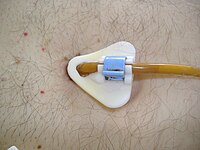
Photo from wikipedia
BAM15 (a mitochondrial uncoupling agent) was tested on cecal ligation and puncture (CLP) sepsis mice with in vitro experiments. BAM15 attenuated sepsis as indicated by survival, organ histology (kidneys and… Click to show full abstract
BAM15 (a mitochondrial uncoupling agent) was tested on cecal ligation and puncture (CLP) sepsis mice with in vitro experiments. BAM15 attenuated sepsis as indicated by survival, organ histology (kidneys and livers), spleen apoptosis (activated caspase 3), brain injury (SHIRPA score, serum s100β, serum miR370-3p, brain miR370-3p, brain TNF-α, and apoptosis), systemic inflammation (cytokines, cell-free DNA, endotoxemia, and bacteremia), and blood–brain barrier (BBB) damage (Evan’s blue dye and the presence of green fluorescent E. coli in brain after an oral administration). In parallel, brain miR arrays demonstrated miR370-3p at 24 h but not 120 h post-CLP, which was correlated with metabolic pathways. Either lipopolysaccharide (LPS) or TNF-α upregulated miR370-3p in PC12 (neuron cells). An activation by sepsis factors (LPS, TNF-α, or miR370-3p transfection) damaged mitochondria (fluorescent color staining) and reduced cell ATP, possibly through profound mitochondrial activity (extracellular flux analysis) that was attenuated by BAM15. In bone-marrow-derived macrophages, LPS caused mitochondrial injury, decreased cell ATP, enhanced glycolysis activity (extracellular flux analysis), and induced pro-inflammatory macrophages (iNOS and IL-1β) which were neutralized by BAM15. In conclusion, BAM15 attenuated sepsis through decreased mitochondrial damage, reduced neuronal miR370-3p upregulation, and induced anti-inflammatory macrophages. BAM15 is proposed to be used as an adjuvant therapy against sepsis hyperinflammation.
Journal Title: International Journal of Molecular Sciences
Year Published: 2022
Link to full text (if available)
Share on Social Media: Sign Up to like & get
recommendations!